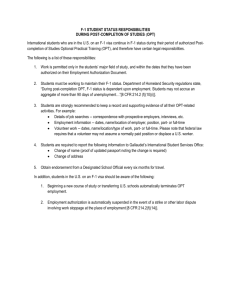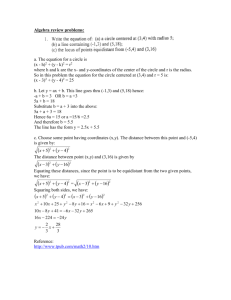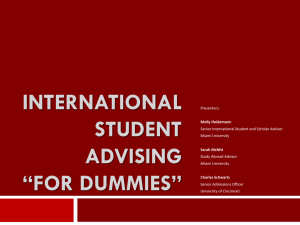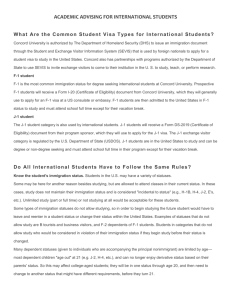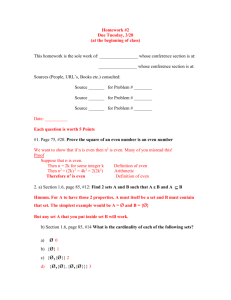F-1 Student Status - The Office of International Affairs
advertisement
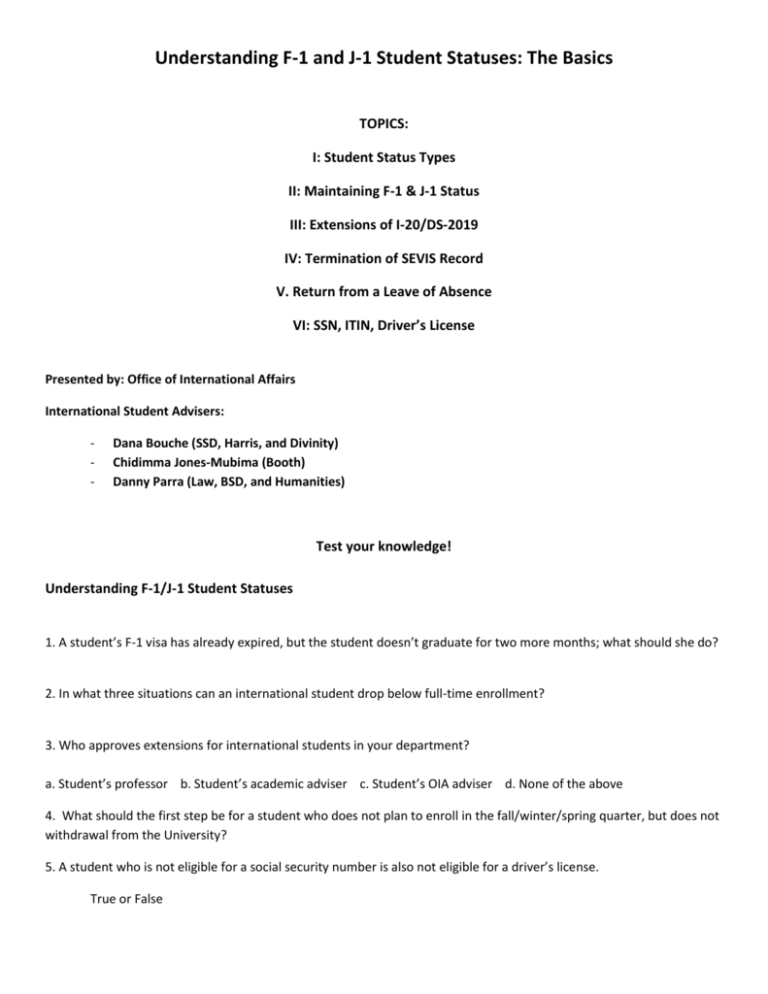
Understanding F-1 and J-1 Student Statuses: The Basics TOPICS: I: Student Status Types II: Maintaining F-1 & J-1 Status III: Extensions of I-20/DS-2019 IV: Termination of SEVIS Record V. Return from a Leave of Absence VI: SSN, ITIN, Driver’s License Presented by: Office of International Affairs International Student Advisers: - Dana Bouche (SSD, Harris, and Divinity) Chidimma Jones-Mubima (Booth) Danny Parra (Law, BSD, and Humanities) Test your knowledge! Understanding F-1/J-1 Student Statuses 1. A student’s F-1 visa has already expired, but the student doesn’t graduate for two more months; what should she do? 2. In what three situations can an international student drop below full-time enrollment? 3. Who approves extensions for international students in your department? a. Student’s professor b. Student’s academic adviser c. Student’s OIA adviser d. None of the above 4. What should the first step be for a student who does not plan to enroll in the fall/winter/spring quarter, but does not withdrawal from the University? 5. A student who is not eligible for a social security number is also not eligible for a driver’s license. True or False I: Understanding F-1/J-1 Student Statuses I: Student Status Types U Chicago sponsors two types of non-immigrant student statuses: F-1 Student Status - Non-immigrant students working towards a specific degree (e.g. BA, MA, PhD, MD) and some exchange program Student intention should be to return home after completion of studies F-1 students can bring spouse/children; they are also issued documents and are in F-2 Status Most are eligible for Optional Practical Training (OPT) & Curricular Practical Training (CPT) work authorization Documents: I-20, F-1 Visa, I-94 Card or Electronic I-94 Record, and Admission Stamp J-1 Student Status - Non-immigrant status used for international exchange; must have outside funding At times, subject to two-year Home Residency Requirement: Student must return to home country for two years before applying for immigrant status J-1 Student can bring spouse/children; they are also issued documents and are in J-2 status Eligible for Academic Training (AT) Documents: DS-2019, J-1 Visa,I-94 Card or Electronic I-94 Record, and Admission Stamp II: Maintaining F-1 & J-1 Status International students must follow governmental rules to “maintain their immigration statuses,” which allows them to stay in the U.S. legally. To maintain status, F-1/J-1 students must: 1: Check-in at OIA within one business day of arriving on campus 2: Update any name or address changes to OIA within 10 days 3: Maintain valid documents 4: Be full-time enrolled every quarter in which they are required to be registered; except during annual vacation quarter (usually summer). Note: Updated policy regarding end of Advanced Residence Registration OIA can authorize a Reduced Course Load (RCL) in only three circumstances: 1: Medical RCL: Student must provide documentation from a licensed physician/psychologist 2: Final Quarter RCL: Student must be in her final quarter 3: Academic Difficulty RCL: Student has initial difficult with English language/American teaching method. Not used very often at U Chicago. 2 Scenario: Collette has come to your office indicating that she would like to take a break in winter quarter, because she has been dealing with personal issues. Can she do this? Would it negatively affect her immigration record? What should be done next in order to not negatively affect her immigration record? III: Extensions of I-20/DS-2019 - Program extensions must be based on compelling academic reasons. Approved by a specific person in each department Students must show funding for extra time (and funding for dependents if applicable) IV: Termination of SEVIS Record *Tip- if a student is beginning to consider not enrolling or enrolling less than full time for the current or future quarter, in which they are require to enroll > Direct student to OIA to discuss options Two main types of terminations for F-1 Students 1. Authorized Early Withdrawal -does not leave a negative mark on the student’s immigration record - Student is able to remain in the US 15-days after record is terminated - Student has options when they want to return from leave - For F-1 students, depending on duration of leave, students will lose time accrued to meet CPT/OPT requirements 2. Unauthorized Early Withdrawal - This leaves a negative mark on the student’s immigration record, which may affect future visa applications. Student does not have a grace period to leave the US For F-1 students, students will lose time accrued to meet CPT/OPT requirements Returning to Active Status – two options 1. Student will need to apply for a reinstatement - 4-6 month process/cannot work during pending application 2. Apply for new I-20, pay SEVIS fee, leave US and return using new I-20, check-in with OIA Requesting an Authorized Early Withdrawal - Student completes OIA’s withdrawal form prior to taking withdrawal or not enrolling in quarter OIA process request and terminates record for “Authorized Early Withdrawal” OIA sends e-mail to student confirming termination Scenario: Mary, a 2nd year MA student, visits your office indicating that she received a great internship opportunity in China. The internship will require her to not register for the spring and summer quarter. She plans to return in the following fall quarter. Is this possible for international students? What does the student need to consider? 3 V. Returning record to Active Status (Return from a Leave of Absence) Option One -Return from a less than 5 months leave (F-1 students only): Processing time is approximately two months, student initiates by contacting OIA adviser Benefits: - If visa is still valid, student does not need to apply for new visa and pay SEVIS fee - Time in full time status the student accrued to meet CPT/OPT eligibility will remain Option Two- Return from a more than 5 months leave and all J-1 students: Student initiates by contact OIA adviser 3-4 months prior to return. Student will apply for new I20/DS-2019 with OIA with support from department. The student pays the SEVIS fee, applies for a new visa, and checks in with OIA VI. Social Security Number, ITIN, Driver’s Licenses Social Security Number: - F-1/J-1 students are only eligible if they have employment (on- campus or off-campus employment) New students must wait 10 days after they have checked-in with OIA before they can apply ITIN: F-1/J-1 students need to apply if… 1. Receive payment for stipend/ fellowship /grant, or 2. Complete an application for an education loan To apply, student schedule an appointment with OIA and bring to the appointment: 1. ITIN Personal Information Sheet (OIA Form) 2. Original Passport 3. F-1 or J-1 visa 4. I-20 or DS-2019 5. Award letter indicating student is receiving grant, fellowship, and stipend or education loan 6. Completed Form W-7 7. Completed Form W-8BENS(if applicable) Driver’s Licenses: Temporary Visitors Driver’s License (TDVL)- License for foreign nationals without a social security number - Student must get a denial letter from Social Security Administration in order to apply for TDVL Scenario: Pierre is a Masters student who is currently on a leave of absences in autumn quarter and plans to return in winter quarter for his final quarter. He will complete all of his course requirements at the end of winter quarter. However, he has plans to pursue an internship in April and he would like to request a program extension to pursue this internship. One reason to pursue the internship is because he wants to apply for an SSN. When should he contact OIA regarding his return from a leave of absence? Can be below full time in winter quarter? Can he apply for the extension? What are his options to apply for an SSN? 4

